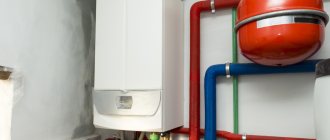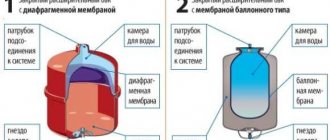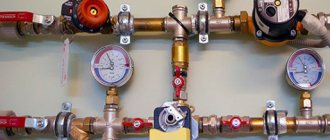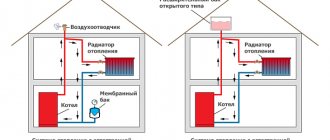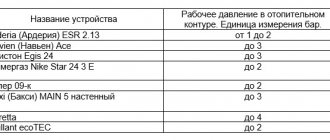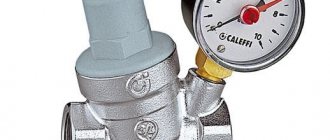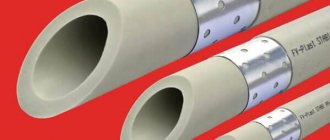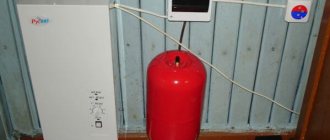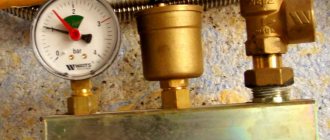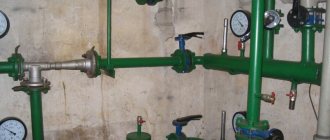Types of pressure
When talking about pressure in the heating system, we mean 3 types:
- Static (manometric). When performing calculations, it is taken equal to 1 atm or 0.1 MPa per 10 m.
- Dynamic, occurring when the circulation pump is turned on.
- Allowable working, which is the sum of the previous two.
In the first case, this is the pressure force of the coolant in radiators, shut-off valves, and pipes. The higher the number of storeys in a building, the more important this indicator becomes. To overcome the rise of the water column, powerful pumps are used.
The second case is the pressure that arises during the movement of fluid in the system. And the operation of the system in a safe mode depends on their sum—the maximum operating pressure. In a multi-storey building its value reaches 1 MPa.
Reasons for the increase in pressure in a gas boiler
In addition to the pressure gauge readings, frequent discharge of water through the safety valve and blocking the operation of the device help to detect an increase in pressure in a gas boiler. Having determined high pressure, first of all, excess air is released through the Mayevsky taps and the boiler is turned off. There may be several reasons for malfunctions.
The normal upper pressure value is ensured by the system by discharging excess coolant through a safety valve into the drain
An increase in pressure in a gas boiler can be caused by damage to the partition of the secondary heat exchanger, which simultaneously serves to insulate and increase the contact area of two circuits - heating and hot water supply.
The secondary heat exchanger takes water from the heating circuit for preparing and supplying hot water in a double-circuit boiler. Damage to the partition leads to the forcing of water from the hot water circuit into the heating system, increasing the pressure in it.
The secondary heat exchanger serves to service the hot water supply system. Water for domestic hot water is heated as a result of contact with the coolant of the heating circuit. The system is protected from mixing the two circuits by a metal partition, damage to which leads to the exchange of liquids and disruption of normal pressure
Replacing the heat exchanger will solve the problem. You can carry out repairs yourself, but it is not advisable to do this, since interfering with the operation of gas equipment requires knowledge and experience in this area. In addition, repairing the boiler yourself will deprive you of the right to warranty service.
A malfunction of the automatic gas boiler or a loose pump impeller, which sucks in air, also increases the pressure in the gas boiler. Equipment malfunctions that lead to disturbances in normal pressure may be the result of a manufacturing defect, a breakdown of the control board, or an incorrectly configured system. Only a qualified technician can fix this kind of problem.
GOST and SNiP requirements
In modern multi-storey buildings, the heating system is installed based on the requirements of GOST and SNiP. The regulatory documentation specifies the temperature range that central heating must provide. This is from 20 to 22 degrees C with humidity parameters from 45 to 30%.
To achieve these indicators, it is necessary to calculate all the nuances in the operation of the system during the development of the project. The task of a heating engineer is to ensure a minimum difference in the pressure of the liquid circulating in the pipes between the lower and upper floors of the house, thereby reducing heat loss.
| Number of storeys | Working pressure, atm |
| Up to 5 floors | 2-4 |
| 9-10 floors | 5-7 |
| From 10 and above | 12 |
The actual pressure value is influenced by the following factors:
- Condition and power of equipment supplying coolant.
- The diameter of the pipes through which the coolant circulates in the apartment. It happens that, wanting to increase temperature indicators, the owners themselves change their diameter upward, reducing the overall pressure value.
- Location of a specific apartment. Ideally, this should not matter, but in reality there is a dependence on the floor, and on the distance from the riser.
- Degree of wear of pipelines and heating devices. If you have old batteries and pipes, you should not expect pressure readings to remain normal. It is better to prevent the occurrence of emergency situations by replacing worn-out heating equipment.
How pressure changes with temperature
The working pressure in a high-rise building is checked using tubular deformation pressure gauges. If, when designing the system, the designers included automatic pressure regulation and control, then they additionally install sensors of various types. In accordance with the requirements specified in regulatory documents, control is carried out in the most critical areas:
- at the coolant supply from the source and at the outlet;
- before the pump, filters, pressure regulators, mud traps and after these elements;
- at the outlet of the pipeline from the boiler room or thermal power plant, as well as at its entry into the house.
Please note: a 10% difference between the standard operating pressure on the 1st and 9th floor is normal.
What should be the pressure in the heating system?
Heating systems can be divided into two types - closed and open. When open, the pressure regulation function is performed by a leaky expansion tank.
The container is installed at the top point of the heating circuit and serves to hold the coolant expanding when heated, to remove air, and also acts as a safety valve. The operating pressure in such a system depends mainly on the temperature of the heating water.
Most often, when organizing heating in houses and apartments, closed heating systems are used. They are more effective and safe, but require constant pressure monitoring.
It is very important to monitor the pressure and temperature of the coolant, and respond to any signs that are not typical for the normal operation of the heating system - knocking, frequent discharge of hot water through the safety valve, cold sections of the circuit
The pressure in a closed-type circuit arises due to forced circulation carried out using a pump. Pressure deviations from the norm can lead to equipment failure.
The nominal pressure in gas boilers of different models may vary; it is determined by the technical characteristics of the equipment
When designing a heating system, the pressure is calculated taking into account the height of the water column, the length of the system, the characteristics of the connected equipment, and the cross-section of the pipes.
To adjust the working pressure, you need to focus on the following parameters:
- Technical characteristics of a gas boiler. The manufacturer indicates the capabilities of the equipment and its settings in the instructions.
- Coolant temperature. The higher the temperature, the greater the pressure in the circuit; as it decreases, it decreases. Therefore, setting and measuring the pressure in the gas boiler and heating circuit must be carried out before and after heating the coolant.
- Volume of the circuit and expansion tank. The size of the accumulator has a direct impact on the pressure in the heating circuit and the range of its fluctuation.
- Acceptable pressure indicators for the least “weak” element of the system. The pressure in the system should not exceed the permissible values for each of its elements. For example, polypropylene pipes, which on average are designed for a pressure of 25 bar at room coolant temperature, can withstand an increase in pressure only up to 7-9 bar at a temperature of 90 °C.
The minimum pressure in the circuit can be 0.5-0.8 bar, the exact standard values are indicated in the instructions, in accordance with them the pressure sensor is adjusted to the required value. If the pressure in the heating system drops below 0.5 bar, an emergency situation occurs, in which the gas boiler may stop or be damaged.
The highest pressure value in the system is up to 3, less often up to 4 bar. For a five-story building, pressure values are adjusted to 5 bar, for a ten-story building to 7 bar. When making settings, it is necessary to adhere to the difference in pressure between the outgoing and return pipes - it should be 0.3-0.5 bar. After starting the heating, check if this is the case.
How to raise blood pressure
Checking the pressure in the heating lines of multi-storey buildings is necessary. They allow you to analyze the functionality of the system. A drop in pressure level, even by a small amount, can cause serious failures.
In the presence of centralized heating, the system is most often tested with cold water. A pressure drop over 0.5 hours by an amount greater than 0.06 MPa indicates the presence of a gust. If this is not observed, then the system is ready for operation.
Immediately before the start of the heating season, a test is performed with hot water supplied under maximum pressure.
Changes that occur in the heating system of a multi-storey building most often do not depend on the owner of the apartment. Trying to influence blood pressure is a pointless undertaking. The only thing that can be done is to eliminate air pockets that have appeared due to loose connections or incorrect adjustment of the air bleed valve.
The presence of a problem is indicated by characteristic noise in the system. This phenomenon is very dangerous for heating appliances and pipes:
- Relaxation of threads and destruction of welded joints during pipeline vibration.
- Stopping the supply of coolant to individual risers or batteries due to difficulties with de-aerating the system, the impossibility of adjustment, which can lead to its defrosting.
- A decrease in the efficiency of the system if the coolant does not stop moving completely.
To prevent air from entering the system, before testing it in preparation for the heating season, it is necessary to inspect all connections and taps for water passage. If you hear a characteristic hissing sound when you test run the system, immediately look for the leak and fix it.
You can apply a soap solution to the joints and bubbles will appear where the seal is broken.
Sometimes the pressure drops even after replacing old batteries with new aluminum ones. A thin film appears on the surface of this metal from contact with water. The by-product of the reaction is hydrogen, and due to its compression, the pressure decreases.
In this case, you should not interfere with the operation of the system - the problem is temporary and goes away on its own over time. This happens exclusively during the first time after installing radiators.
You can increase the pressure on the upper floors of a high-rise building by installing a circulation pump.
Attention: the farthest point of the pipeline is the corner room, therefore, the pressure here is the least.
Minimum pressure
Based on the condition that the superheated water in the heating system does not boil, the minimum pressure is assumed.
| Water temperature, degrees C | Minimum pressure, atm |
| 130 | 1,8 |
| 140 | 2,7 |
| 150 | 3,9 |
It can be defined as follows:
A margin of approximately 5 m is added to the height of the house (geodesic) to avoid airing, plus another 3 m for the resistance of the heating system inside the house. If the supply pressure is insufficient, then the batteries on the upper floors will remain unheated.
If we take a 5-story building, then the minimum supply pressure should be:
5x3+5+3=23 m = 2.3 ata = 0.23 MPa
